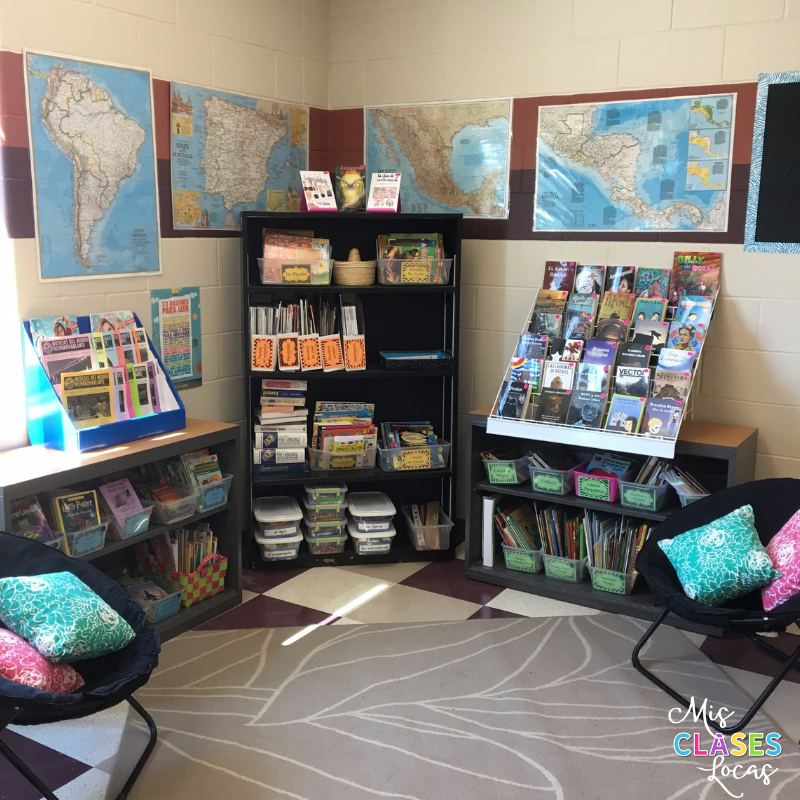Inside: Interpersonal Speaking practice and assessments in Spanish class. Spanish conversation in class. Ways to get students to practice speaking, as well as options for how to assess interpersonal speaking in Spanish class.
Hi friends! This is Allison from Mis Clases Locas and today is all about Interpersonal Communication! Below are my favorite ways to practice, as well as assess the Interpersonal Mode.
Interpersonal Speaking Practice
Find Someone Who – speaking conversation practice for the novice on up
– Students interview the whole class, in small groups, or with one partner.
– I have started these as early as a week into Spanish 1, just using one verb.
Question Cards – Spanish conversation speaking practice for the novice on up – Question Card Post
– Large cards can be posted around the room for gallery walk style speaking.
– Small cards can have multiple sets printed and each set given to a small group or partners.
– There are differentiated options including the yo form prompt for more support, and without for those who are ready.
– High frequency Verbs Question Cards (present) – Get students up and moving while asking and answering simple questions to get to know each other.
– Can use variations each week to weekend chat, talk about where you went, or chat about a novel.
Rotating Partner Conversations – speaking practice for novices on up
– Break up a text or topic and have students speak with a partner for 30 seconds or a minute over a topic and then rotate to keep going.
– Can have timed slides that rotate with what to talk about next.
Conversation Circle – speaking practice for novices on up
– This happens pretty often in my upper-level class, especially during our Lit Circle Unit.
– Basically, put students in small groups and let them chat in Spanish. It works best to pick the groups and give them a specific topic to chat about. For novice students, it also works better if they have some questions to start with to support conversation.
Fishbowl Interpersonal Speaking
– This could be a speaking practice or a way to administer an assessment.
– The simple explanation is 1/3 of the class is in the center in “the fishbowl” where they speak. The other 2/3rds are on the outside where they listen. Those on the outside must trade to tag into the conversation. It works great with a controversial topic as a way to organize the conversation.
Café y Conversación – upper level
Learn more about Café y Conversación.
Interpersonal Speaking Assessments
From most supported Novice to Upper level
In Pairs at Teacher Desk – With Question Cards
– Back when I wrote how to assess a novel in 2016, interpersonal speaking with question cards was not even mentioned. (If you want to read more about teaching a novel, check out Teaching a Novel 101).
I have posted multiple times since then on social media about how I am learning to better support novice students in speaking assessments. The biggest change came from an idea from my instructional coach when she asked how I would differentiate the assessment for my students with IEP’s. Our solution was to have me type up general, open-ended questions about the book. There are two separate colors for two different levels of questions for students to choose from, depending on if their goal is to be proficient or to show thorough understanding.
– Now I have taken that a step further and have students practice with these conversation cards in many ways during the unit. I make multiple sets, laminate them and then they are a perfect fast finisher activity or class starter while I get things ready. Yes, there are some practiced memorized responses, but that is what novice baby parrots do.
– See below for how I use these in an assessment, but just with the addition that the pair of students draw about five random questions to ask each other in Spanish.
In Pairs at Teacher Desk – Student Created Questions
– They know that there is a proficiency level that they are trying to work towards, as I grade them using a performance-based rubric. For example, 4-Novice High, 3-Novice Mid, 2- Novice Low, below that try again. Students are usually terrified for their first one because it is so different from assessments in most classes, but then realize they would much rather have this an open-ended assessment and consider it easy, “You just listen and talk in Spanish!”
Simultaneous Small Groups
 |
| I spread all mini rubrics out by the group on my rolling standing desk & wheel around to listen to all groups at the same time. |
In Advance
– We spend a class period working on writing good, open ended questions over our topic(s). Have small groups do a “question writing competition,” writing as many as they can in 10 minutes. Then groups rotate papers, star open-ended questions, heart the best one, and fix any errors. We rotated a couple of times, then students write their own list of personal questions.
– I have students’ names written on these mini Speaking Rubrics and split them into random small groups of about four students.
The Day of the Assessment
– I give students some time to prepare and I split them into their groups around the room. They bring their pre-written questions to the group.
– *NEW & I would highly recommend* I also gave each group a laminated set of bail-out questions to help support those team members who show up not prepared, as well as to keep the conversation going. This made sure that other group members were not punished for being put in a group with someone who was not prepared. It also gave them more to talk about, which meant longer for me to walk around and hear everyone talk.
– I walk around and assess everyone on the spot. *If you have really big classes, or need more time to grade, you could have the small groups record their conversations and listen to them later.*
– After about 10 minutes I reshuffled students into new groups. Students might say some of the same things, but they are more confident on round two. If needed, you can also rearrange them into groups you have already graded and those you still need to hear. (They do not know this and I am often camped out in the middle of a few groups, specifically listening to certain students answer).
– After multiple speaking assessments at my desk, my Spanish 2 just had their first small group assessment recently. Overwhelmingly, they liked this style of assessment more. But, this is because they were ready. I personally would not try this as an assessment with Spanish 1, since they do not have the vocabulary to sustain a conversation long enough for me to float around and hear all groups.
– On these days I do have to be on my A-game and ready to listen to many students at once, but I do like that by the end of class, I have them pretty much graded. Besides recording, you could even do this kind of assessment more frequently but only assess maybe half the class at a time.
Other Interpersonal Assessments
– Have students record & listen later (Flipgrid)
– With larger classes, I know that recording and listening later is often the last resort. Just do not burden yourself with too much out-of-class grading!
– Fishbowl Interpersonal Speaking
– If it is an assessment, be very clear with expectations and make sure everyone gets a chance to speak in the center.
– 7 Speaking Activities Your Students Will Love
If you are still looking for more ideas, check out this great post from Jessica on SSS with more speaking activities.


















2 Comments
I know that grades are the bane of most teachers’ existence…but it remains that we must assign grades for performance. So, I’m curious as to how you translate the rubrics pictured under “simultaneous small groups” into your gradebook. Any help for a first-year teacher who doesn’t know where to begin?
David, Allison here & I used standards based grading. Check out this blog post to learn more! https://misclaseslocas.com/standard-based-grading-in-spanish-class/